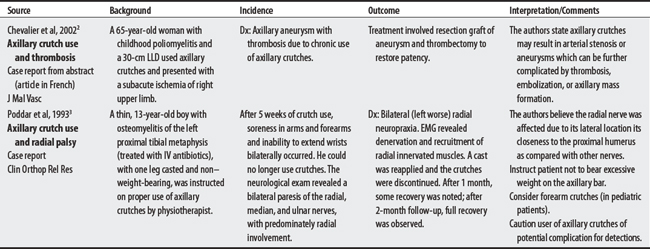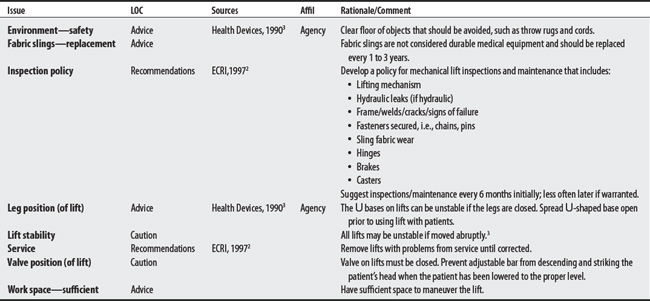Chapter 29 Assistive Devices
OVERVIEW.
Canes are wooden or metal walking devices that are held in one hand and designed to aid in stability and to “take some of the weight off one foot.”1 Straight and quad canes offer one and four points of support, respectively. Hemi-walkers (walk-canes) offer four points of support with a wider base than that provided by a quad cane.2
SUMMARY: PRECAUTIONS.
Some procedural concerns relate to proper fitting and appropriate use of canes. For example, canes are not designed to unweight a limb of a patient with a protected weight-bearing status. Twenty-six cane-related injuries were reported to the FDA from December 1990 to November 2002; the majority of injuries involved quad canes. Three quad cane-related deaths were reported to the FDA between 1997 and 2003.3
ADVERSE EVENTS
FOOD AND DRUG ADMINISTRATION REPORTS
FDA: Cane-Related Fatalities3
| Date of Report | Brand | Fatal Event (death) |
|---|---|---|
| 1/14/03 | Quad cane large base | A dialysis patient’s foot slipped under the base of the cane, resulting in a sprained ankle and fractured right patella. Following foot slipped under the base of hospitalization, the patient was transferred to a skilled nursing facility for rehabilitation and died from complications due to an unrelated health condition. |
| 2/12/01 | Adjustable quad cane | Attorney alleged that while an individual used a quad cane, it snapped, and the individual fell, sustaining injury that subsequently led to death (no details). |
| 2/04/97 | Adjustable quad cane | Attorney reported that while an individual was using a quad cane to rise from a chair, the cane snapped and the individual fell, suffering a fractured spine. The individual subsequently died. |
Note: Cane-related deaths. MDR and Maude3 reported deaths.
1 Eisenberg MG. Dictionary of rehabilitation. New York: Springer, 1995.
2 Miller-Keane encyclopedia and dictionary of medicine, nursing, and allied health. ed 7. Philadelphia: W.B. Saunders; 2003.
3 U.S. Food and Drug Administration. Center for Device and Radiological Health. Available at: http://www.fda.gov/cdrh/mdr/. Accessed November 7, 2005
4 Tan JC. Practical manual of physical medicine and rehabilitation: diagnostics, therapeutics, and basic problems. St. Louis: Mosby, 1998.
5 Pierson FM, Fairchild SL. Principles and techniques of patient care, ed 3. Philadelphia: Saunders, 2002.
6 Sainsbury R, Mulley G. Walking sticks used by the elderly. BMJ. 1982;284:1751.
7 Pain H, McLellan L, Gore S. Choosing assistive devices: A guide for users and professionals. London: Jessica Kingsley, 2003.
8 Schmitz TJ. Preambulation and gait training. In O’Sullivan SB, Schmitz TJ, editors: Physical rehabilitation and treatment, ed 4, Philadelphia: F.A. Davis, 2001.
29.2 Crutches
OVERVIEW.
Crutches are wooden or metal walking devices that extend from the floor to the vicinity of the elbow or the axilla. Axillary crutches terminate proximally with cross bars near the user’s axilla, whereas forearm crutches (Loftstrand) end proximally with hinged open cuffs located just below the elbow.1
SUMMARY: CONTRAINDICATIONS AND PRECAUTIONS.
Crutch concerns tend to be either musculoskeletal (arthritis, weakness), device-related (worn tips), or procedural (improper use of crutches). Cases report poor crutch usage, which has resulted in vascular (thrombosis) or neurological complications (neuropraxia).2,3
OTHER ISSUES.
Note 1: Mechanical failure: While great emphasis has been placed on monitoring crutch tips for wear, the majority of crutch-related injuries reported to the FDA appear to have been mechanical failure-related (e.g., metal cracking, bolt failure). Only seven of 38 reported incidences involved the patient slipping.4
CONTRAINDICATIONS AND PRECAUTIONS
M00-M99 DISEASES OF THE MUSCULOSKELETAL SYSTEM AND CONNECTIVE TISSUE
1 Eisenberg MG. Dictionary of rehabilitation. New York: Springer, 1995.
2 Chevalier J, Joly P, Dhoine P. Axillary aneurysm and crutches. J Mal Vasc. 2002;27(1):36-38.
3 Poddar SB, Gitelis S, Heydemann PT, et al. Bilateral predominant radial nerve crutch palsy. A case report. Clin Orthop Rel Res. 1993;297:245-246.
4 US Food and Drug Administration. Center for Device and Radiological Health. Available at: http://www.fda.gov/cdrh/mdr/. Accessed November 7, 2005
5 Schmitz TJ. Preambulation and gait training. In O’Sullivan SB, Schmitz TJ, editors: Physical rehabilitation and treatment, ed 4, Philadelphia: F.A. Davis, 2001.
6 Tan JC. Practical manual of physical medicine and rehabilitation: diagnostics, therapeutics, and basic problems. St. Louis: Mosby, 1998.
7 Pain H, McLellan L, Gore S. Choosing assistive devices: A guide for users and professionals. London: Jessica Kingsley, 2003.
8 Pierson FM, Fairchild SL. Principles and techniques of patient care, ed 3. Philadelphia: Saunders, 2002.
29.3 Lifts, Mechanical
OVERVIEW.
A mechanical lift is a hydraulic-, battery-, or mechanically powered device used to lift and transfer or transport a patient in the horizontal or other required position from one place to another. The device includes straps and a sling to support the patient.1
SUMMARY: CONTRAINDICATIONS AND PRECAUTIONS.
Mechanical lift concerns are either device-related (appropriate model for the task) or procedural-related (proper use of the device during transfers; proper maintenance).2,3 Thirty-two lift-related deaths have been reported to the FDA from 1990 to 2002. In almost 80% of these cases, deaths were sling or strap related.1
FDA1 MECHANICAL LIFT-RELATED DEATHS
| Dates | Outcome | Possible Contributing Factors |
|---|---|---|
| MDR 7/26/96-8/31/90 and Maude 9/23/96-3/14/2002 | 34 deaths |
29.4 Vibratory Devices
CONTRAINDICATIONS AND PRECAUTIONS
G00-G99 DISEASES OF THE NERVOUS SYSTEM
I00-I99 DISEASES OF THE CIRCULATORY SYSTEM
L00-L99 DISEASES OF THE SKIN & SUBCUTANEOUS TISSUE
1 Eisenberg MG. Dictionary of rehabilitation. New York: Springer, 1995.
2 Umphred DA. Classification of treatment techniques based on primary input systems: Inherent and contrived feedback/loops systems and their potential influence on altering a feedforward motor system. In: Umphred DA, editor. Neurological rehabilitation. St. Louis: Mosby, 1995.
3 Bishop B. Vibration stimulation II. Vibratory stimulation as an evaluation tool. Phys Ther. 1975;55:29-33.
Stay updated, free articles. Join our Telegram channel

Full access? Get Clinical Tree






















